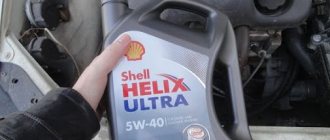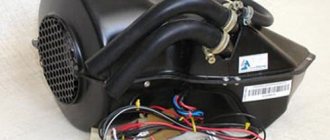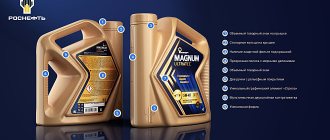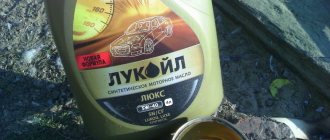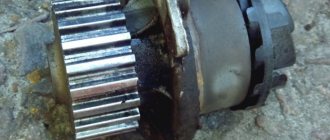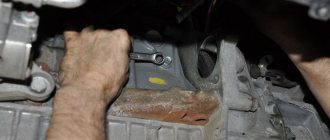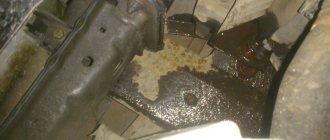If the antifreeze level decreases, but no liquid leaks are noticed from the outside, it means that it is getting into the engine lubricant. The fact that antifreeze goes into the oil is a bad thing, since a loss of lubricating properties occurs, the load on the engine increases, which leads to its failure. This is facilitated by one of the components of antifreeze - glycol. Its chemical properties provoke the formation of an ever-growing potential, which blocks the quality characteristics of the oil.
The appearance of antifreeze in oil: what are the signs?
The first thing a motorist should be concerned about when he notices that the coolant is decreasing is where it accumulates or where it ends up. Of course, if there are no obvious signs of antifreeze leaking under the vehicle (it is dry underneath), but the liquid disappears, then you should pay attention to signs that show that antifreeze is getting into the oil. The presence of the following signs allows you to quickly determine why the coolant level changes sharply.
- Antifreeze is visible on the oil level dipstick
The engine runs unevenly when idling. The car is getting damaged.
- When checking the oil level, the dipstick showed drops of antifreeze.
- The upper liquid level quickly tends to the minimum.
- Detection of unusual antifreeze drips under the head.
- At high speeds, air bubbles are observed in the expansion tank.
- Oil streaks are visually visible on the outer wall of the expansion tank.
- Traces of coolant are visible on the crankcase.
- Change in color of antifreeze. Over several months it becomes significantly darker and fades, even to black.
- When examining the spark plugs and their seating grooves, traces of coolant are found.
- Increased exhaust concentration - carbon monoxide in the expansion tank exceeds the permissible content.
- Coolant accumulates in the pan.
Repairing faults if antifreeze leaks on VAZ models
The above information applies to radiator repair. If the problem is not in the radiator, but in the heater core, then a sealant will also help fix the problem. If the effect of the sealant turns out to be powerless, then it is necessary to disassemble the ventilation system and replace the core.
If the antifreeze leak occurs due to the fact that electrolysis destroys the core of the stove, then attaching a grounding bracelet helps best. The second option is to replace the aluminum material with brass. As a rule, this problem occurs on Chrysler models.
Among other things, the antifreeze expansion tank should also be inspected for faults. Its main function is to drain excess antifreeze. An additional function is to provide a reservoir when antifreeze is displaced by pressure. This happens when the system experiences excessively high temperatures. When the temperature drops, the coolant returns to its original place. Thus, if there is a leak in this tank, the antifreeze does not return to the system and gradually decreases, which leads to overheating of the engine. To repair cracks in the tank, it is recommended to use silicone glue. In case of a complete replacement, you should make sure that the connections to the tank are made correctly, because any bending can lead to the formation of new cracks.
If the leak is caused by an antifreeze plug, the problem should be repaired using one of the following methods:
- Cleaning the cork, sanding with sandpaper. Then you need to fix the plug on both sides and expose it to high temperatures. The cork should become denser
- The old cork is knocked out with tools. The resulting hole must be lubricated with sealant. Then you should install a new plug
If a leak is found in the hose, then the easiest way to fix this problem is a complete replacement. Repairing a hose is very difficult and unprofitable. It's better to buy a new one and replace it. At the same time, it is recommended to replace the clamps, since over time the rings lose their properties.
If antifreeze is leaking due to a malfunction of the water pump, then the repair should be carried out in the same way, that is, simply replace the part with a new one. As a rule, this procedure on VAZ cars is not difficult.
The appearance of antifreeze in the cabin is always unexpected and unpleasant. Antifreeze under the driver's feet or on the front passenger's side usually indicates a malfunction of the heater radiator. Here we will look at the leak of antifreeze into the car interior using the example of VAZ-2101, VAZ-2102, VAZ-2105, VAZ-2106, VAZ-2107. Eliminating this problem has almost the same algorithm for other Zhiguli models.
So, find antifreeze in the cabin
Possibly due to a rusted heater radiator or a metal pipe or heater tap. A visual inspection will help determine the exact cause. If the problem is caused by the heater valve or pipe, then they must be replaced, and you will not have to disassemble the bar panel and radiator casing. If the radiator is to blame, then the solution depends on its type.
- The old-style radiator (copper) can be repaired, it can be soldered, cleaned, etc. The main task here will be to find a good master;
- The aluminum radiator cannot be repaired, all that remains is to throw it away and buy a new one.
Briefly about the reasons for antifreeze getting into the engine oil
Microcracks in cylinder head
Experienced drivers will immediately be able to point out the reason why there is antifreeze in the oil, but everything is not as simple as it might seem at first glance. The first thing they talk about is the cylinder head. First of all, this is gasket burnout. Such a breakdown is directed either to the external environment outside the block, or inside it. When a burnout occurs in the direction of the engine compartment, it is immediately visible from the drip. In addition, there are a number of other reasons why oil gets into the antifreeze, such as:
- Microcrack in the cylinder block
- Deformation of the head, which is caused by overheating, long-term operation or overtightening of the bolts.
- Corrosion phenomena in cylinder liners.
All these problems can be eliminated with the help of car services, turners, boring machines, and milling machines. It is important to know that if the gasket burns out from inside the block, then it is much more difficult to determine such a malfunction. In order to detect this breakdown, be sure to inspect the car every day and pay attention to the slightest changes in its operation.
Antifreeze found in oil in time will not cause serious consequences. That is why it is so important to carry out a daily visual inspection of all accessible units and systematically service the machine from a specialist.
Why does coolant get into the car oil?
The reasons why antifreeze went into the oil may be the following:
- The cover is burnt out. Between the cylinder head and the cylinders there is a metal lining. High temperatures in the combustion chamber and cooler increase the wear of this spare part. If you operate the car correctly, the lining will last approximately one hundred thousand kilometers. However, if the part is constantly overheated or filled with low-quality coolant, the part becomes deformed and the coolant goes into the lubricant.
- Cracks. While running, the engine heats up and cools down. This causes the metal to crack. Through the cracks, the coolant enters the lubricant complex. The negative impact increases if you start the engine in low temperature conditions.
- The block head was deformed. This problem appears after repairing the motor (if the head was removed). In view of this, major repairs should be entrusted to specialists.
- Defective pad. Even among new spare parts there are low-quality products. Replacing a part with a defective one will definitely not fix the problem.
Buy spare parts only from reliable retail outlets. Do not use the services of car services that employ employees whose qualifications are questionable.
We recommend reading: Where does the VAZ 2114 antifreeze go?
Consequences of mixing antifreeze and engine oil
Although oil is a liquid, it contains no water - only mineral components and additives. It is this fact that ensures the absence of corrosion processes in lubricated areas. But a tiny amount of water is enough to start the process of oxidation of the surface of the lubricated metal. If this malfunction is detected in time and corrected promptly, serious consequences can be avoided, with the exception of a small output. But if water affects the crankshaft/camshaft bushings and other engine components for a long time, their rapid wear is inevitable.
In cars with diesel engines, coolant getting into the oil can lead to corrosion of the cylinder walls and the appearance of defects that impede the movement of the pistons. In the worst case scenario, this threatens to jam the engine and cause complex and expensive repairs.
We also do not forget that as a result of the effect of ethylene glycol, which forms the basis of modern antifreezes, on the lubricating fluid, the viscosity of the MM decreases, worsening the traction of the engine and increasing the rate of its wear, and the viscosity of the antifreeze, on the contrary, increases, complicating the circulation of the refrigerant through the lines of the cooling system.
There is no need to explain the consequences of such options. What’s worse is that often the deterioration of the power unit’s performance occurs so slowly that it can go unnoticed for a long time, and when the car owner does notice something is wrong, it is no longer possible to correct the situation without carrying out restoration work.
It is impossible not to note another unpleasant consequence of mixing technical fluids. If the oil goes into the antifreeze (and we have already noted that due to the higher pressure in the lubrication system, the likelihood of this particular direction of mixing is always high), more suitable conditions for increased soot formation appear. In this case, microscopic particles of unburned antifreeze residues (and these are numerous additives and additives) settle on the internal surfaces of the engine, leading to its coking. The oil filter also suffers greatly, becoming clogged and reducing the oil pressure in the system.
Simply replacing the filter is ineffective, since the resource of the new filter element will be much less than normal. So it’s impossible to do without promptly eliminating the causes of mixing oil and antifreeze. But this will not be enough - you will have to flush both systems, and this is a costly procedure. And in terms of money, and in time, and in terms of effort expended.
So if you notice symptoms indicating the presence of lubricating fluid in antifreeze, you should not leave solving the problem for later - it may be too late.
Hidden problems
You have looked at everything and everyone, there are no leaks anywhere, all the hoses and clamps are in order, but the antifreeze or antifreeze goes away, “even if you crack”! The fact is that there are not only open leaks, but also so-called hidden ones, and they are much more dangerous.
A car engine is not a cast structure - there is a separate engine block and cylinder head. There is a gasket between these two parts, this is mandatory, it is high-temperature (can maintain high positive values), and it is also a sealing link. In the engine block, as well as in the cylinder head, there are channels through which antifreeze (antifreeze) passes, cooling the metal, thus the “entire engine” is at an operating temperature that does not exceed 90 - 100 degrees Celsius, without this fluid the engine would very quickly warmed up and it simply jammed.
So, the coolant also passes through the gasket, since it is an intermediate link (by the way, it has special channels). If the gasket is defective or poorly tightened, the tightness of the channels is broken and coolant can pass into the engine cylinders. That is, it will enter the combustion chamber, then through this chamber it will exit into the exhaust pipe, while the level of antifreeze (antifreeze) will decrease in the expansion tank.
What are the signs of such a breakdown?
- This is white and thick smoke from the exhaust pipe, it will really be like fog - we read about it here.
- The engine oil level will rise.
- The oil will be interspersed with antifreeze or antifreeze, that is, with bubbles.
- Coolant will leak out of the reservoir, and constantly.
In this case, it is 100% a gasket; we must change it. After all, sometimes antifreeze or antifreeze can get into the engine oil, and this is serious! Here the capital is just a stone's throw away.
Because:
- The oil mixes with the liquid and forms an incomprehensible “slurry”; it will begin to coagulate, which will clog all the channels - overheating of the engine is guaranteed.
- It will not be able to properly lubricate the engine cylinders, this will lead to wear of the piston rings.
- Also, this substance will clog all the channels on the crankshaft, which will also increase its wear; the liners in which it rotates can simply turn.
Bottom line - if antifreeze or antifreeze goes into the engine, driving is prohibited!
This is reason number “1”, however, antifreeze can also flow through various channels of the cooling system. They also have gaskets adjacent to the engine block and when they wear out they leak.
About the white coating on candles
If a white coating has formed on the spark plugs, the reasons may be different. First of all, this indicates problems with fuel quality. But if it is a rough white coating on the spark plugs, the reasons are due to overheating of the engine. Also, similar soot forms if:
- The spark plug is not suitable for this engine (by heat rating or other parameters).
- The inlet pipe is leaking. Here air will be taken in from outside.
- Poor ignition calibration.
- There are problems with the cooling system (for example, a faulty radiator).
Elimination method
When a significant amount of lubricant gets into the antifreeze, the latter is unable to work as a coolant. It forms clots and even solid particles that settle on the walls of the channels, clogging the thermostat valve and clogging the radiator. There is also no guarantee that mutual penetration has not occurred and antifreeze has not leaked into the oil pan. Hence the conclusion: both liquids must be drained .
If your car is equipped with an oil cooler, immediately contact a service station to locate the broken gasket. Then decide whether to carry out the repairs yourself or entrust the work to car service personnel.
What to do if oil or emulsion is found in the expansion tank with antifreeze:
- Both systems need to be flushed. Before draining the antifreeze, add a special detergent composition to the expansion tank and let the engine idle for 5 minutes. Empty the lubrication system immediately.
- Unscrew and discard the oil filter.
- Replace the gasket on the cylinder block by removing the cylinder head. During the dismantling process, disassemble the elements of the cooling system (pipes, pump, thermostat) and thoroughly rinse them by hand. Do the same with the heat exchanger if it is the culprit for mixing liquids.
- Unscrew the oil pan and oil pump, disassemble the latter and change all gaskets. Before assembly, wash the parts with gasoline or solvent.
- Assemble the power unit, install a new filter and fill in engine flushing lubricant. Instead of antifreeze, fill the system with distilled water and add detergent.
- Start the engine and let it run for 10–15 minutes without increasing the speed. Keep an eye on the oil warning light and temperature gauge.
- When finished, replace the water with a working fluid - antifreeze, and the flushing oil - with full-fledged engine oil. It is highly advisable to change the filter twice.
Advice. When pre-flushing the cooling system before eliminating the malfunction, monitor the temperature and pressure of the lubricant. If you notice something is wrong, immediately turn off the engine, as the oil still gets into the antifreeze.
No matter how carefully you try to wash the engine parts during disassembly, you will not be able to get to all the channels. Therefore, flushing is performed several times, including after starting the power unit. During further operation, monitor the condition of the process fluids so that the problem does not recur.
Which oil filter is better?
The first step is to separate oil filters by engine type (gas, gasoline and diesel engines). The fact is that in diesel engines the oil becomes much more contaminated; when a diesel engine burns, a large amount of soot is formed plus a large load on the engine. Therefore, you need to take seriously the selection of a high-quality filter in a diesel car.
The main criterion for filters by which they differ is the cleaning principle. They are divided into:
- mechanical
- magnetic
- centrifugal
- gravitational
The mechanical type of oil purification has become the most popular in our time. The principle of its operation is that it passes oil through special calico, which traps dirt particles. Mechanical filters, in turn, are divided into fine, medium and coarse filtration. A fine filter purifies oil by passing oil through a paper membrane, and medium and coarse filtration through wire plates. But it is worth noting that there is almost no difference between medium and coarse filtering.
Baldwin is considered one of the most trusted companies on the market; they have a fairly wide range of products (about 700 types). This company is trusted by millions of car owners.
